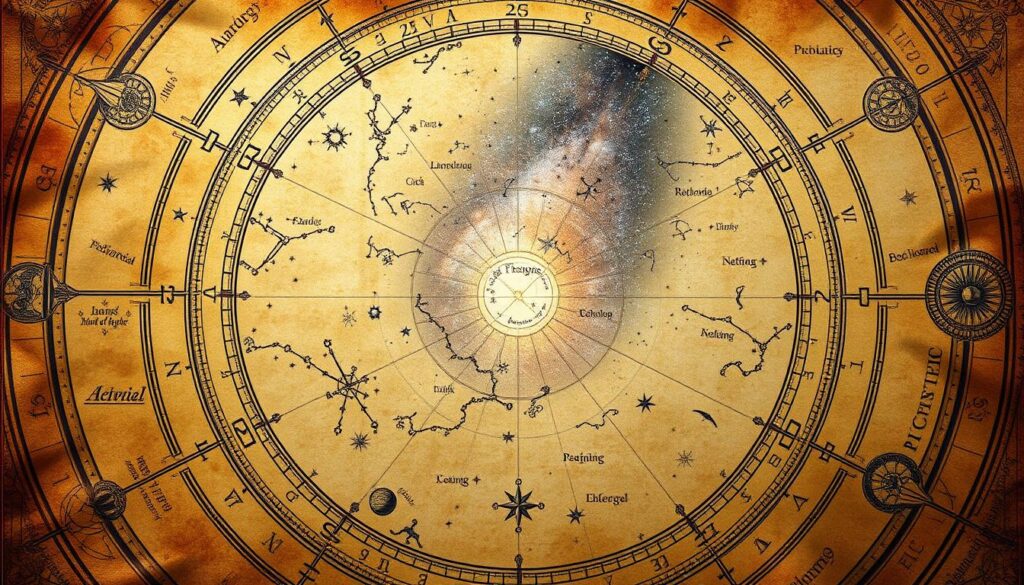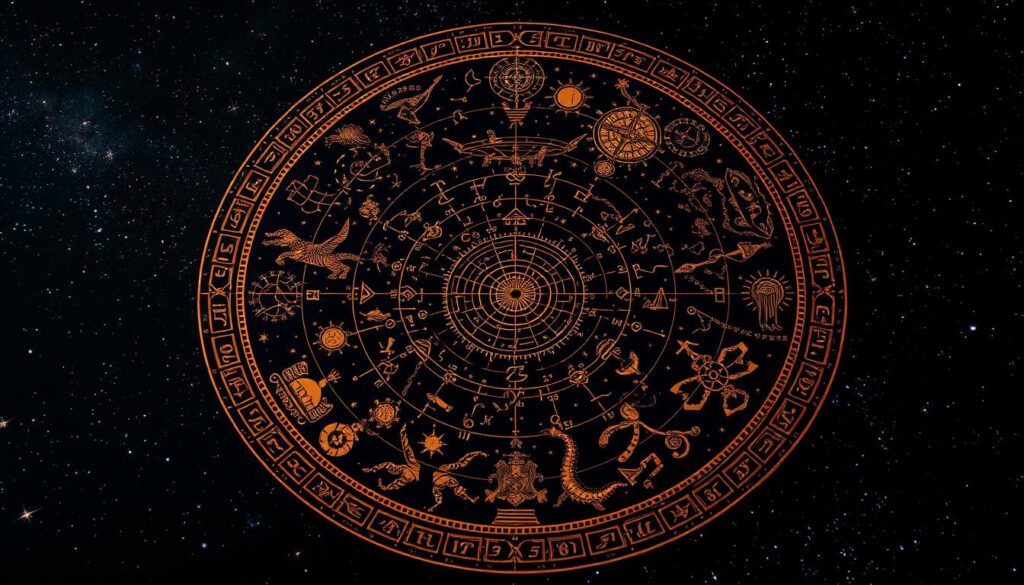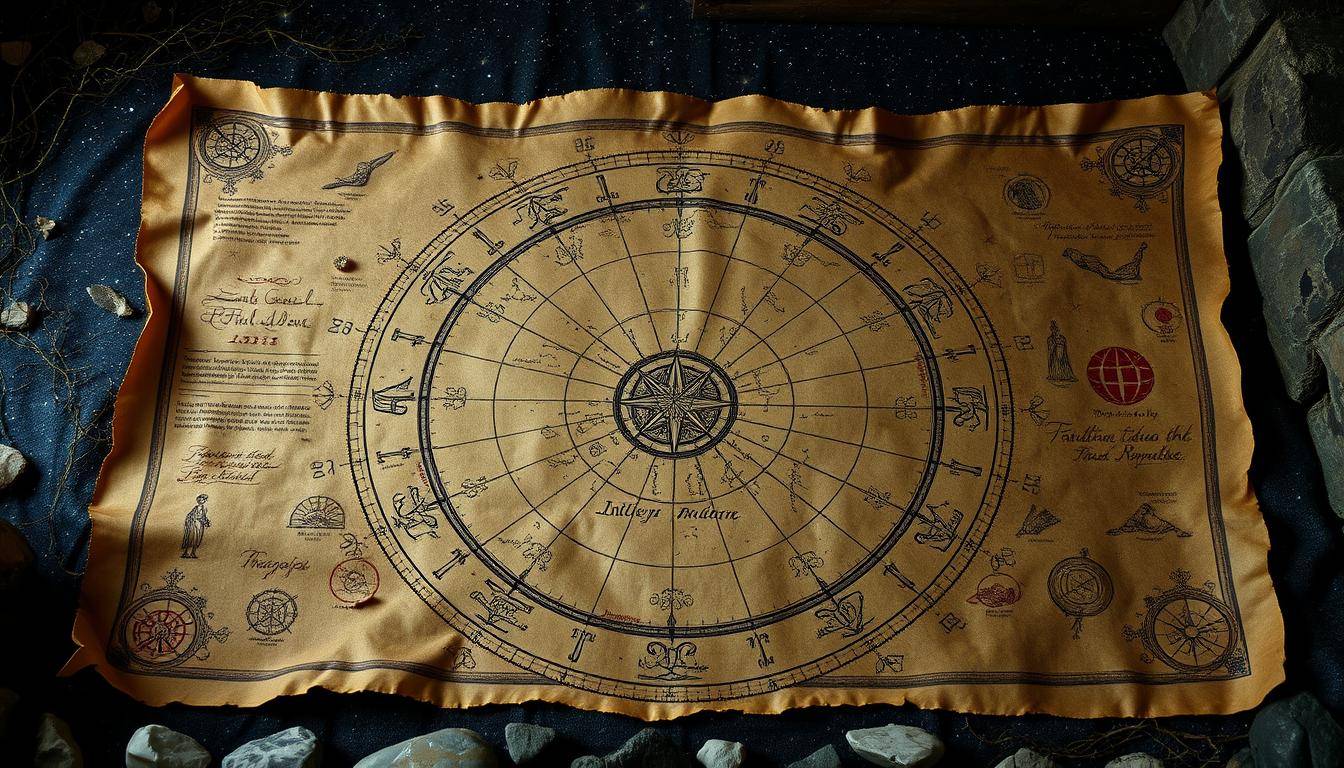“The cosmos is within us. We are made of star-stuff. We are a way for the universe to know itself.” – Carl Sagan
Ancient star maps have always fascinated us, showing what our ancestors knew about the sky. From the Sumerians to the Maya, many cultures have left us these detailed maps. They show how advanced our ancestors were in understanding the stars, making us rethink our own scientific journey.
Recently, finding a piece of a star catalog by Hipparchus has sparked new interest in these maps. As we explore these ancient star maps, we find a rich mix of knowledge, culture, and our eternal search for cosmic understanding.
Key Takeaways
- Ancient civilizations around the world developed sophisticated star maps and celestial recording techniques.
- Recent discoveries, such as the fragment of Hipparchus’s star catalog, have challenged conventional timelines and pushed back the origins of scientific astronomy.
- Ancient star charts reflect cultural, religious, and practical applications of astronomical knowledge, from navigation to agricultural planning.
- The study of ancient star maps provides insights into the precision and mathematical prowess of our ancestors, as well as their profound connection to the cosmos.
- Ongoing research and preservation of these ancient celestial documents offer opportunities to bridge the gap between ancient wisdom and modern scientific understanding.
The Discovery of Hipparchus’s Lost Star Catalog
The ancient world’s quest to map the stars has taken an exciting turn. Scholars have found a fragment of what might be the oldest complete star catalog ever. This find is hidden in a medieval parchment at St. Catherine’s Monastery in Egypt. It sheds new light on the work of the Greek astronomer Hipparchus.
The Hidden Manuscript at St. Catherine’s Monastery
The fragment is thought to be a copy of Hipparchus’s lost star catalog from the 2nd century B.C. It was hidden for centuries until multispectral imaging revealed it. Researchers found the faint coordinates and measurements for the constellation Corona Borealis. These date back to around 129 B.C., when Hipparchus was active.
Multispectral Imaging Revelations
Multispectral imaging technology has been key in uncovering this ancient treasure. By analyzing the document under different light wavelengths, researchers exposed the hidden star map. This map had been hidden for centuries by overwriting and scribal activity.
Dating the Ancient Observations
The coordinates and measurements on the fragment confirm Hipparchus’s groundbreaking work. These observations, from around 129 B.C., give us a glimpse into the dawn of scientific astronomy. They highlight the achievements of this ancient Greek scholar.

The discovery of this lost star catalog fragment at St. Catherine’s Monastery is a testament to ancient knowledge. It shows the power of our pursuit to understand the universe. As we continue to uncover the past, the legacy of Hipparchus and other pioneers shines brighter than ever.
Ancient Star Maps and Their Hidden Messages Through History
The story of ancient star maps is more than just about stars. They were filled with cosmic symbolism and star knowledge. This knowledge showed the spiritual and cultural beliefs of old civilizations. From Sumerian clay tablets to Egyptian tomb paintings, each culture had its own way of seeing the stars.
These ancient documents give us a peek into our ancestors’ minds. They show how our early ancestors understood the sky. They reveal how we used the stars for navigation, rituals, and early science.

Star mapping has come a long way, from Babylon to the Gaia mission. Each step has shown how smart our ancestors were. As we learn more, we connect ancient wisdom with today’s science.
“The night sky has always been a source of wonder and inspiration, and the ancient star maps are a testament to our enduring fascination with the cosmos.”
These star maps have shaped human history. They were used for many things, like finding our way and planning seasons. By exploring their secrets, we honor our ancestors’ curiosity and creativity. And we’re reminded of the magic of the night sky.
The Evolution of Celestial Cartography
Celestial cartography has a long history, starting with the Babylonians and ending with Greek mathematics. It shows how humans have always wanted to know the universe better.
From Babylonian Observations to Greek Mathematics
The Babylonians were the first to record star positions. But it was Hipparchus, a Greek astronomer, who changed everything. He used two coordinates to map stars, starting scientific astronomy.
The Birth of Scientific Astronomy
Hipparchus mapped the whole sky, using the celestial equator. His work, found in the Codex Climaci Rescriptus, was incredibly accurate. He was off by just one degree.
Development of Coordinate Systems
Hipparchus’s work made astronomy more scientific. He mixed Babylonian methods with Greek geometry. This led to better ways to understand the universe.
| Period | Key Developments | Contribution |
|---|---|---|
| Babylonian Astronomy | Measurement of star positions along the zodiac | Established early foundations of celestial cartography |
| Greek Mathematics | Introduction of two-coordinate system by Hipparchus | Revolutionized the field of scientific astronomy |
| Hipparchus’s Observations | Mapping of the entire sky with unprecedented accuracy | Shifted astronomy from descriptive to predictive science |
The story of celestial cartography shows ancient astronomers’ genius. It goes from the Babylonian astronomy to the Greek mathematics. Their discoveries still guide us today.
Decoding Ancient Astronomical Knowledge
Exploring the secrets of ancient astronomy is a thrilling adventure. We look at artifacts like star maps, stone carvings, and texts. These help us understand how our ancestors saw the sky.
The Babylonians from the 2nd century B.C. were skilled astronomers. They recorded eclipses, lunar phases, and planets in their almanacs. They even created a calendar that matched the solar and lunar years.
- The Babylonian calendar had twelve months, each with its own name, like Nisannu (Nisan), Airu, and Dûzu.
- They added a thirteenth month in some years to keep the seasons in sync.
- They used their knowledge for timekeeping, navigation, planning, and rituals.
Recently, lost manuscripts were found, like those at St. Catherine’s Monastery. New imaging techniques revealed hidden texts and drawings. These include works by Eratosthenes and Hipparchus, giving us a peek into ancient wisdom.
| Ancient Astronomical Discoveries | Key Figures | Significance |
|---|---|---|
| Babylonian Astronomical Almanacs | Babylonian Astronomers | Advanced understanding of celestial phenomena, soli-lunar calendar system |
| Rediscovery of Eratosthenes’ “Catasterisms” | Eratosthenes | Insights into mythological associations with constellations |
| Uncovering Hipparchus’s Lost Star Catalog | Hipparchus | Earliest known comprehensive star catalog created by humans |
By studying ancient astronomy, we gain new insights. This connects our ancestors’ wisdom to our modern understanding of the universe. It shows their ingenuity and inspires us to explore the cosmos further.
The Cultural Significance of Early Star Charts
Early star charts were more than just maps of the sky. They connected our world to the heavens. These charts linked to religious beliefs and myths, showing our deep bond with the universe.
Religious and Mythological Connections
In ancient times, star charts were filled with symbols from religions and myths. They showed gods, heroes, and other celestial beings important to cultures. Seeing and understanding the stars was seen as a sacred skill, giving insight into the universe’s order.
Navigation and Timekeeping
For sailors, star charts were key for finding their way. They used the stars to navigate the seas and find safe routes. Farmers also used them to plan planting and harvesting, keeping food coming all year.
Agricultural Planning and Seasonal Markers
Stars and constellations marked the seasons for farmers. They planned their crops based on these signs, working with nature’s cycles. This shows how much ancient cultures valued the sky and its secrets.
“The stars we see are the same stars our ancestors saw thousands of years ago. By studying their celestial mythology and navigation, we can glimpse into the rich tapestry of human civilization and our enduring connection to the cosmos.”
Archaeological Evidence of Ancient Astronomical Observations
Archaeoastronomy shows us how ancient people knew a lot about the stars. They built stone circles and aligned structures to watch the sky. Places like Stonehenge in England and Chichen Itza in Mexico show their skill in tracking stars.
Artifacts like the Antikythera Mechanism prove they could predict the stars with great accuracy. This shows their deep understanding of the universe.
The Codex Climaci Rescriptus is a key find. It’s an old manuscript in Egypt, written in the 5th or 6th century AD. It has nine folios with astronomy from around 129 BC.
It’s believed to be Hipparchus’s oldest star catalog. This is before Ptolemy’s famous work by nearly three centuries.
Thanks to multispectral imaging, we can see the star map hidden in the Codex. It’s the oldest complete star map found. Hipparchus’s catalog had about 850 stars, more accurate than Ptolemy’s.
| Astronomical Artifact | Key Findings |
|---|---|
| Codex Climaci Rescriptus |
|
| Antikythera Mechanism |
|
| Stonehenge and Chichen Itza |
|
The study of ancient astronomy is fascinating. It shows how our ancestors understood the stars. From Hipparchus’s star catalog to the Antikythera Mechanism, their knowledge is impressive.
As we learn more, the story of humanity’s quest to understand the universe becomes more amazing.
“The discovery enriches the understanding of Hipparchus and the mathematization of nature in Western civilization.”
Mathematical Precision in Historical Star Mapping
Ancient astronomers were incredibly precise in mapping the stars. They used advanced ancient astronomy tools to measure the celestial coordinates of stars with great accuracy. Often, their measurements were correct to within just a single degree.
Measurement Techniques and Tools
They used tools like the astrolabe and armillary sphere to track stars. The Dunhuang star atlas, from the Tang Dynasty, shows their skill. It maps 1,339 stars and 257 asterisms with precision ranging from 1.5-4° for the brightest.
Accuracy of Ancient Coordinates
Hipparchus, a famous astronomer, also showed great precision. His catalog of about 850 stars was accurate to within a single degree. This was impressive, given the tools they had.
Precession Calculations
Hipparchus discovered the precession of the equinoxes. This shows their deep understanding of the Earth’s axis shift. By noticing this change, they could date their observations with great accuracy. This helped lay the groundwork for our modern view of the universe.
“The Dunhuang star atlas is considered one of the most spectacular documents of the history of astronomy.”
The skill and precision of ancient astronomers still amaze us today. They remind us of the vast knowledge and talent that existed long before modern science.
The Legacy of Ancient Astronomers
The work of ancient astronomers like Hipparchus and Ptolemy has greatly influenced astronomy. Their discoveries are the base of modern astronomy. They changed how we see the sky, inspiring many scientists.
Their hard work in observing and math helped us understand the universe better. They created systems to track stars and figured out how the Earth moves. These efforts still guide us today.
“The work of ancient astronomers like Hipparchus and Ptolemy laid the groundwork for the scientific revolution, inspiring generations of scientists to push the boundaries of our understanding of the universe.”
Today, we still study and keep their old documents and tools. The Nebra sky disk and the Antikythera mechanism show how smart our ancestors were. They give us a peek into the past.
Their work is still important as we explore space. It shows us the value of understanding the sky. It motivates scientists today to keep learning.
- They started modern astronomy and predictive science.
- Their ideas helped science grow in many areas.
- They inspired many scientists to keep exploring.
- They left us important artifacts to study and admire.
As we look into space, we remember the ancient astronomers. Their work shows our endless curiosity and drive for knowledge. Their legacy shapes how we see the universe today.
Modern Implications of Historical Star Charts
Today, ancient star charts and astronomy observations have big impacts on our world. They not only reveal our past but also help us understand the sky better.
Scientific Validation Methods
Scientists use advanced methods like multispectral imaging to find hidden details. This helps them check if ancient astronomy data is correct. By studying these old texts, scientists learn more about the sky and how it has changed.
Contemporary Archaeological Applications
Historical star charts are very useful in archaeology. They help date sites and give important background information. They also help us understand historical events, cultural changes, and how astronomy influenced ancient societies.
Historical star charts connect our past and present understanding of the universe. They help in science and archaeology, making our view of the world richer.
“The study of ancient star charts not only illuminates our past but also holds the key to unlocking the secrets of our future.”
Preservation and Study of Ancient Astronomical Documents
Keeping ancient astronomical documents safe and studying them is a big challenge. Multispectral imaging has changed how we read palimpsests and old texts. Places like St. Catherine’s Monastery are key in protecting these important documents. They help us learn more about ancient science and history.
The Dunhuang Star Atlas is a standout example. It’s the oldest star atlas found, from the early Tang Dynasty. It lists 1,339 stars and 257 asterisms. It shows how ancient astronomers used math.
This atlas was found by Aurel Stein in 1907. Now, it’s at the British Library.
The Fragmentum mathematicum Bobiense is another exciting find. It’s a palimpsest with Greek math texts and diagrams. It was hidden under Latin writing. This was found in the 19th century at Bobbio Abbey’s library.
Studying these ancient texts helps us understand past civilizations better. It’s important to keep these documents safe. They help connect ancient knowledge to today’s science.
Conclusion: Bridging Ancient Wisdom with Modern Understanding
The study of ancient star maps connects our past with today’s science. These maps, made by ancient astronomers, show how far we’ve come. They help us understand our history and the start of science.
Looking into these maps, we see how smart our ancestors were. Their work helps us today and makes us appreciate their legacy. It shows how ancient wisdom can lead to new discoveries in fields like medicine and energy.
Thinking about these star maps reminds us of our endless quest to know the universe. This shared goal across cultures and time shows our strength and curiosity. By learning from the past and using today’s science, we can reach new heights. We can live in a world filled with compassion, wisdom, and respect for our place in the universe.
FAQ
What are ancient star maps and why do they captivate researchers?
Ancient star maps show us what our ancestors knew about the stars. They reveal their advanced skills in observing the sky. These maps also tell us about their beliefs, how they navigated, and their scientific progress.
What is the significance of the Hipparchus star catalog discovery?
Finding a piece of Hipparchus’s star catalog in Egypt was a big deal. It proves he mapped the whole sky using a special system. This was a groundbreaking achievement in astronomy.
How have ancient star maps been used throughout history?
Star maps were linked to myths and helped with navigation and planning. They connected the sky to everyday life for ancient cultures.
How did the evolution of celestial cartography shape the development of scientific astronomy?
The shift from Babylonian to Greek astronomy was key. Hipparchus’s work brought math to astronomy. This change was a big step towards modern science.
What insights do ancient astronomical artifacts provide into the observational skills of our ancestors?
Finds like stone circles and the Antikythera Mechanism show ancient astronomers’ skill. They could track the stars with great accuracy.
What is the significance of the legacy left by ancient astronomers like Hipparchus and Ptolemy?
Hipparchus and Ptolemy’s work has inspired many scientists. Their contributions helped astronomy move from describing to predicting the sky.
How do modern researchers use historical star charts for contemporary scientific applications?
Modern tech like multispectral imaging helps us study ancient star maps. This research aids in dating artifacts, understanding history, and learning about cultural and celestial changes.
What challenges and opportunities exist in the preservation and study of ancient astronomical documents?
Places like St. Catherine’s Monastery protect these important documents. Ongoing research keeps uncovering new texts, expanding our knowledge of ancient science.




























































